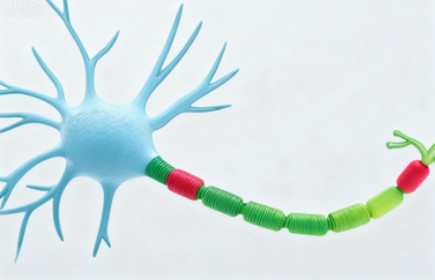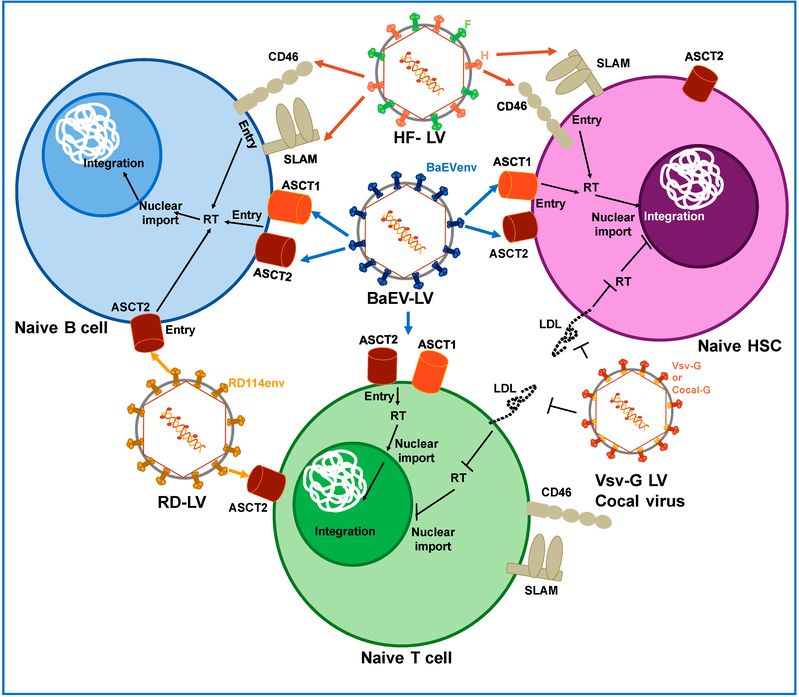Pseudotyping of Lentiviral Vector for Targeting Neuronal Cell
With the availability of profound cell therapy knowledge, certified technical staff, and numerous state-of-the-art instruments, Creative Biolabs has developed a number of viral vector development solutions for worldwide customers. With our proven competencies and regulatory expertise, we are therefore confident in offering the best services for lentiviral vector (LV) pseudotyping services targeting neuronal cells.
Neuronal Cells Introduction

Neuronal cells are a number of cells that play an important role in regulating the function of nervous tissues. In the past few years, many kinds of neuronal cells have been identified in the brain, including sensory neuronal cell, glia neuronal cell, as well as central neuronal cell. Meanwhile, pilot studies have shown that neuronal cells are associated with a variety of diseases and have been considered as therapeutic targets in pre-clinical or clinical studies. For instance, scientists have revealed that neuronal cell death can induce the function degeneration of nervous system, causing the progress of various neurodegenerative diseases or neurological injury, such as Alzheimer's disease, Parkinson's disease. Furthermore, researchers have illustrated that a range of neuronal cell type markers can be widely used for revealing the expression patterns in disease therapy. Among them, Rbfox3, Aif1, and Gfap are commonly used for detecting different neuronal cells. Pseudotyping lentiviral vectors with the glycoprotein demonstrate a high-titer transport and expression in neuronal cells, which provides new opportunities for neurological disease treatments.
Why Are Neurons So Difficult to Target?
Post mitotic properties: Neurons are terminal differentiated cells that do not divide. This characteristic makes them resistant to classical retroviral vectors, which require host cell division to integrate their genomes into the host's chromosomes. LV avoids this problem, making it the cornerstone of neuronal gene transfer.
- The blood-brain barrier (BBB): The BBB is a highly selective semi permeable membrane that strictly regulates the pathways through which substances enter the brain from the bloodstream. This barrier is composed of specialized endothelial cells with tight connections, which can prevent most systemically administered gene therapy vectors from reaching their target neurons.
- Complex morphology: The complex dendritic and axonal dendritic structures of neurons can extend over long distances, requiring effective transport and localization of gene products throughout the cell to achieve normal function. The delivery system must be capable of effective transduction and subsequent intracellular transport.
Lentiviral Vectors Pseudotyping
The main challenge that LV still faces is achieving cell type specificity. This is where powerful pseudo typing techniques come into play.
 Figure 1. Pseudotyping of lentiviral vectors.1
Figure 1. Pseudotyping of lentiviral vectors.1
What is Pseudotyping?
Pseudotyping is a complex molecular biology technique in which the natural lentiviral envelope (Env) protein that determines cell orientation is replaced by a heterologous envelope glycoprotein of another virus. This process essentially involves replacing the key with a lock, giving the left ventricle a new ability to bind to specific receptors on target cells.
The pseudovector consists of a lentiviral core (containing a genetic payload) and a novel non-natural envelope protein. This engineering enables the carrier to bypass non-specific infections and achieve precise delivery to the desired cell population.
The Importance of Pseudotyping for Neuronal Targeting
Pseudotyping allows for highly selective transduction of neuronal subtypes by selecting envelope proteins that have a tendency towards specific neuronal receptors. This precision is crucial for minimizing off target effects and potential toxicity, which is a major safety issue in the delicate environment of the central nervous system. This strategy is also essential for studying the function of specific neuronal subtypes.
Essential Components of Lentiviral Vector Systems for Neuronal Targeting
| Component Type | Function | Examples for Neuronal Applications |
|---|---|---|
| Transfer Vector | Carries genetic payload | Neuron-specific promoters |
| Packaging Plasmids | Provides structural proteins | 2nd/3rd generation Gag/Pol constructs |
| Envelope Plasmid | Determines cellular tropism | VSV-G, RVG, Mokola, LCMV glycoproteins |
| Accessory Plasmids | Enhances transduction | Cre recombinase |
Core Services at Creative Biolabs
Lentiviral vectors play a critical role in transferring targeted genes into the host cells and have been widely used in gene therapy. In general, lentiviral vectors are often derived from human immunodeficiency virus (HIV). The binding of envelope proteins with other kinds of viruses in HIV has been considered as a key step for pseudotyping of lentiviral vectors. To date, pseudotyped lentiviral vectors in neuronal cells have aroused much attention for treating neurological diseases. As a consequence, Creative Biolabs offers a wide selection of lentiviral vector-based pseudotyping services targeting on neuronal cells. We have successfully accomplished several projects in this field, and the results indicate that these lentiviral vectors can offer an efficient transfection in gene therapy of neurodegenerative diseases. For example, we have developed a lentiviral vector by using the equine infectious anemia virus (EIAV). This vector can efficiently integrate the gene of interest into different kinds of nervous systems. Moreover, we have also produced many types of high-titer EIAV vectors by pseudotyping with envelope glycoproteins from different species of viruses, such as Lyssavirus, rabies virus, and Mokola virus.
Lentiviral Vector Manufacturing Process
- Vector Design and Optimization: Preliminary consultation to select the optimal carrier skeleton (such as HIV-1 and EIAV) and envelope glycoprotein (new fusion complexes such as RV-g, VSV-g, FuG-e, etc.) based on the customer's target cells/circuits. This involves codon optimization and promoter selection (such as the Synapsin promoter used for neuron specific expression).
- Producer Cell Line Transfection: Using optimized serum-free medium, the four-plasmid system was transiently transfected on a large scale and at high density into HEK293T producer cells adapted to the suspension to achieve maximum yield.
- Viral Harvest and Clarification: Collect the virus supernatant 48-72 hours after transfection, and then perform microfiltration to remove cell debris and residual production cells.
- Concentration and Purification: Ultracentrifugation: Pseudo carriers, especially those containing VSV-G and RV-G, have high stability and can be effectively pelletized through sucrose pads.
- Chromatography: Advanced purification steps such as anion exchange or membrane chromatography are used to remove process and host cell contaminants, resulting in high concentration and pure products suitable for in vivo injection.
- Final Quality Control and Release: Conduct comprehensive analysis and testing on the final concentrated virus stock solution.
Our Advantages
- Technical Leadership in Neuronal Tropism Customization
- End-to-End GMP-Aligned Quality Control
- Fast Turnaround & Flexible Scalability
- PhD-Level Full-Cycle Support
- Cost-Effective Custom Solutions
Frequently Asked Questions
Q: What factors should I consider when selecting an envelope for neuronal targeting?
A: The choice of envelope protein depends on several factors, including the specific neuronal population you wish to target, the delivery method (in vitro or in vivo), and the desired transduction properties. VSV-G remains a popular choice for broad neuronal transduction and high titers, while RVG exhibits enhanced selectivity for neuronal cells by binding to nicotinic acetylcholine receptors. For retrograde tracing applications, modified rabies glycoprotein is an ideal choice. Our technical team can provide detailed guidance based on your specific experimental requirements and target cells.
Q: How stable are pseudotyped lentiviral vectors and what are optimal storage conditions?
A: Properly purified and formulated pseudotyped lentiviral vectors maintain good stability when stored at -80°C in our optimized buffer system. Avoid repeated freeze-thaw cycles, as each freeze-thaw cycle reduces the infectious titer by 10-50%. For long-term storage, we recommend aliquoting the vector into single-use volumes. Some envelope proteins are more stable than others—VSV-G pseudotyped vectors are particularly stable, while vectors pseudotyped with certain other envelope proteins may have a shorter shelf life. We provide detailed stability information for each pseudotyped vector in our Certificate of Analysis.
Q: What is the typical titer range for your neuronal-targeted pseudotyped lentiviral vectors?
A: Titer ranges vary depending on the specific envelope protein and production batch, but for most pseudotyped viruses, our standard concentration is generally between 10^8 and 10^9 TU/mL. Higher concentrations can be achieved through additional ultracentrifugation steps, but this may result in some loss of infectious particles. We measure both physical and functional titers (using flow cytometry in test cell lines) to fully characterize each formulation.
Q: Can your pseudotyped lentiviral vectors be used for in vivo applications in the nervous system?
A: Yes, our vectors are widely used for in vivo neuronal transduction via various delivery methods, including stereotactic injection, intrathecal delivery, and, in some cases, systemic administration. The optimal delivery method depends on the target brain region and the specificity of the pseudotyped envelope. We can provide guidance on injection parameters, dosage, and safety based on our extensive experience in various animal models. All vectors used in vivo undergo additional endotoxin testing and sterility verification to ensure biocompatibility.
Connect with Us Anytime!
As a leading service provider in the field of viral vector design and construction, Creative Biolabs is dedicated to providing a wide range of services on pseudotyping of lentiviral vectors targeting on neuronal cell. Our scientists specialized in gene therapy studies will work with you to develop a most appropriate strategy that will offer the most meaningful data for your research. If you are interested in our services, please contact us for more details.
Reference
- Gutierrez-Guerrero A, Cosset F L, Verhoeyen E. Lentiviral vector pseudotypes: precious tools to improve gene modification of hematopoietic cells for research and gene therapy. Viruses, 2020, 12(9):1016. https://doi.org/10.3390/v12091016 (Distributed under Open Access license CC BY 4.0, without modification.)
